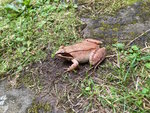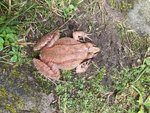 Narrowsburg
NarrowsburgLight Rain Fog/Mist, 43°
Wind: 8.1 mph
 Narrowsburg
NarrowsburgDo you know how to tell a frog from a toad? Many of us mistake one for the other. While both are amphibians, once you have the details on how to distinguish these compelling critters, as well as …
Stay informed about your community and support local independent journalism.
Subscribe to The River Reporter today. click here
This item is available in full to subscribers.
Please log in to continue |



Do you know how to tell a frog from a toad? Many of us mistake one for the other. While both are amphibians, once you have the details on how to distinguish these compelling critters, as well as their individual species, you can see they differ in ways that make them easier to identify.
For starters, what makes them similar? Amphibians are vertebrates, so, like humans, they have backbones. Frogs and toads are also ectothermic, which means that their body temperature is affected by the temperature of their surroundings.
As predators, frogs and toads consume a wide variety of insects and worms, and help to keep pest populations in check. Both have sticky tongues for getting the job done. Frog tongues are attached to the back of the mouth, so their reach is shorter than that of toads, whose long tongues are attached at the front. As a result, frogs rely on ambushing prey with a quick leap to get closer, while toads can creep up and gain more reach with their longer tongues.
In general, frogs display more streamlined body types, while toads are stockier overall. Both have external eardrums, called tympana, which pick up vibrations via a ring of sensitive thin skin.
Frogs and toads both produce sounds via a voice box and vocal sacs. Those sounds help to set species apart. The wood frog makes a sound similar to that of ducks quacking. The Eastern American toad delivers a long trill that is often mistaken for crickets. If you hear this call in spring, you are likely listening to a toad; in fall, count on the source being a cricket.
Both amphibians can breathe through their skin on land, but there the similarity ceases. Frogs have skin that is typically smooth and moist, while toads exhibit dry skin that is bumpy or warty. As a result, frogs prefer habitats that are damp or aquatic, while toads enjoy dryer, more earthy habitats.
Neither amphibian is active during winter. Frogs usually hibernate under water, or beneath mud or leaves. Toads hibernate on land by digging holes in the leaf litter or soil below the frost line. As for eggs—frogs lay theirs mostly in free-floating clusters, while toad eggs appear in strings.
Frogs and toads are also environmental indicators that can help us monitor the health of our regional aquatic and terrestrial environments. Their thin skin heightens their sensitivity to water, land and air pollutants. When populations decline, or abnormalities occur, these warning signs should be taken seriously to determine how best to support our amphibians.
Visit https://bit.ly/3xK1su5 or https://on.ny.gov/3CHujD9 to learn more.
Comments
No comments on this item Please log in to comment by clicking here